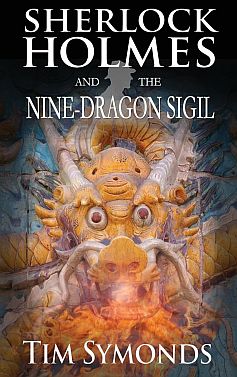Sherlock Holmes and the Nine-Dragon Sigil-Tim Symonds
By Chris Middlehurst
Published on June 18, 2017

In a recent resurgence of dark, brooding office-based paranoid thrillers with climaxes in abandoned car parks and sterile airport lounges helmed by the likes of John le Carre and Robert Harris, I was very much looking forward to reading a throwback to the great late 19th Century detective with the kind of title that would not seem out of place in a pulp magazine or a midnight movie theatre. I had not read any books by Tim Symonds before but I had high hopes that a story that places an English archetype on the other side of the world would be as wild and nutty as the cover and concept both suggest.
And I must admit that on the whole I was satisfied. At over 300 pages long, one would expect a tale of considerable scope, but Symonds I believe wisely limits the reach of his narrative and the palette of his characters to keep the pace constant and the plot strands in check. Whilst I love the original Arthur Conan Doyle novels, I did feel that some such as A Study in Scarlet and The Valley of Fear were let down by overlong and not strictly necessary flashbacks in which the pieces of the puzzle were slowly reassembled. In this sense, Symonds’ novel is much closer in tone and pace to the Sherlock short stories in which Doyle really mastered the craft of this nation’s favourite sleuth. Like a game of Cluedo, Symonds does not cheat and puts the limited playing pieces and settings to good use: we know it’ll be either Colonel Mustard or Reverend Olive with the lead pipe, and not some resentful parlour maid introduced in the last three minutes of the game with a makeshift weapon not previously mentioned in the rule book. Symonds’ use of imagery and his control of Watson’s narrative voice is also consistent with the drollery and matter-of-factness that made the Doyle stories so entertaining in the first place. I also liked the times when Symonds steps into Doyle’s dreamy consciousness and reminisces on poaching heydays and jungle dreams.
I mean it as a compliment when I say that, apart from a few anachronistic instances (such as when one character says “thirty-six” instead of the late-Victorian nomenclature six-and-thirty) and a couple of spelling miskates, this book could be mistaken for a penny paperback or novella of the kind Doyle and his contemporaries were bashing out onto paper for a living. Where I would argue that Symonds actually surpasses Doyle is in his well-wrought presentation of the Chinese characters, particularly General Yuan Shi-Kai, an intelligent and complex character who cleverly blasts out of the window the kind of stereotypical Dr Fu Manchu villainy too often associated with tales of the far Orient. Symonds’ limited use of graphic imagery in detailing the more gruesome aspects of dynastic Chinese Imperialist culture is also effective in brief passages that are never exploitative or gratuitous. Despite tales of exploding crows, castration and horrific punishments, it never descends into a haunted house of horrors or a gruesome feast of the cheesy damned. This is not some Imperialist Chinese rehash of the catering nightmares of Indiana Jones and the Temple of Doom, I can assure you. Or is it? … Better read and find out!
There are a few missteps where I felt the work could have been more effective. For example, Symonds’ opening transportation of the Holmes-Watson saga from the seething smogginess of London’s dark winding alleyways to a more twee gentrified England of swan-feeders and beekeepers was a bit of a surprise for me as a first-time reader. Symonds also swamps his early passages with a little too much explanation about the dynamo duo’s literary success, and the constant nudge-nudge-wink-winks to previous adventures in the Holmes-Watson cannon were unnecessary and more than anything slowed the pace down. It is also clear that Symonds is in love with the historical references and literary quotations that he surrounded himself with when he sat down to write his book. Nothing wrong with that, but his insistence on conveying this to the reader in frequent quotations might fascinate some yet irritate others. And his dialogue lacks the memorable wit that made other parodies of the Baker Street detective such as Mark Twain’s A Double-Barrelled Detective Story and the Michael Robert Johnstone-scripted 2009 Guy Ritchie film adaptation so fun to listen to in one’s imagination. Then again, his development of Holmes’ irritable and often impatient attitude towards his bumbling colleague is a joy to behold. I was also pleasantly surprised by his delicate portrayal of Empress Dowager Cixi as an enigmatic character with little dialogue, but wisely kept that way. For where would the enigma be if she were an imperial motor-mouth with the voice of a fog horn?
Despite whatever qualms I have raised, what can I say more about this text than simply that I enjoyed it. I finished it in under two and a half days and being a slow reader I consider that quite an achievement. Sherlock Holmes and the Nine-Dragon Sigil (mind: pronounced “sijil” not “seagull”) is a pleasingly breezy novel that requires little note-taking and even manages a few semi-spine-tingling surprises along the way. Faster than a filarial worm, it will induce stomach cramps and howls of pain in only the most cynical and sarcastic of readers. Thank you, Mr Symonds, for brightening my day.
The Author

Chris Middlehurst is The New Jurist film review editor. Chris graduated from Leeds University with a BA in English Literature, where he served as President of the LUU Film Making Society and also took elective modules in Chinese, Italian and World Cinema. He currently lives in Leeds and volunteers regulary at the wonderful Hyde Park Picture House, where he urges film lovers to visit if they get the chance!


